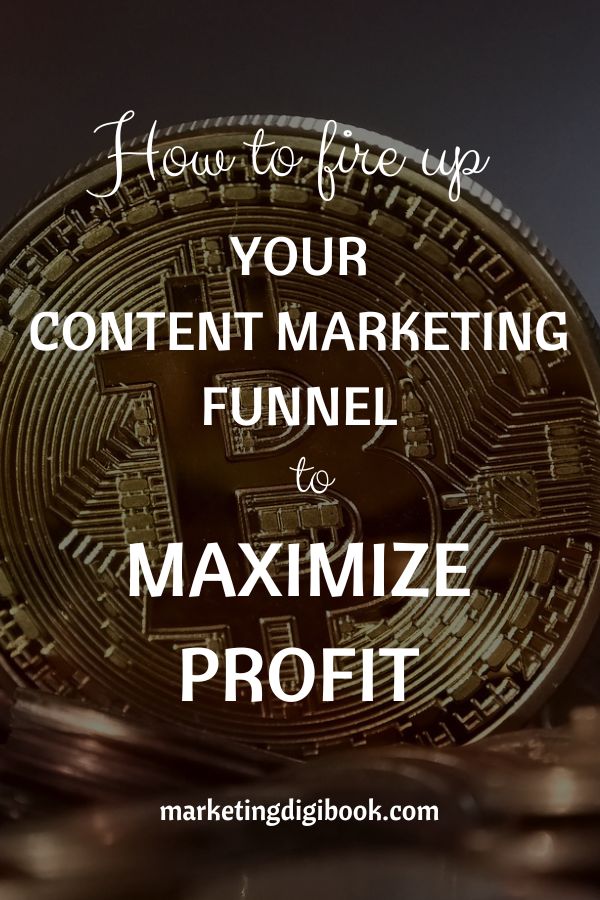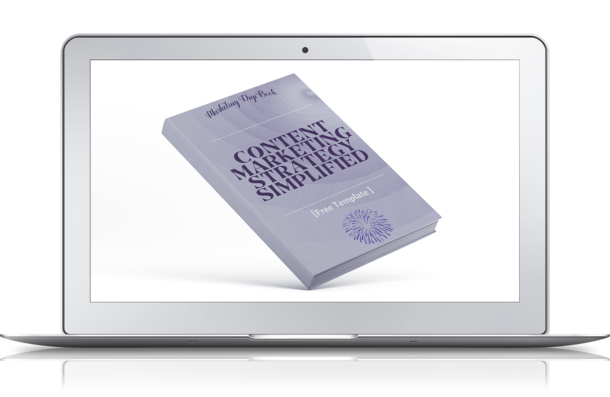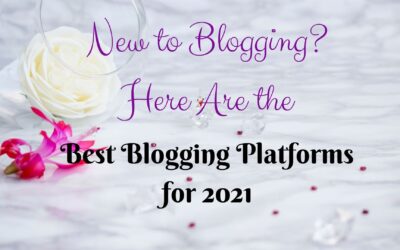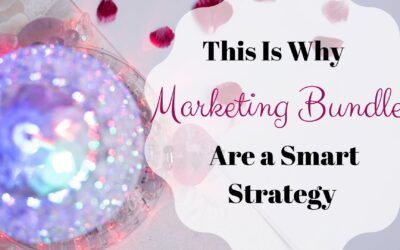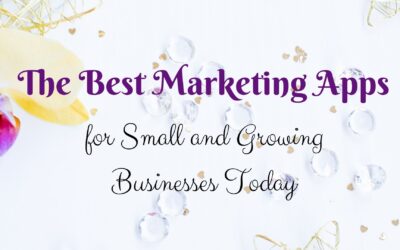Content marketing funnel! Voila, some other fancy name, and apparently a Gordian knot that you need to solve. But wait, that doesn’t need to be overwhelming, if you approach the notion step by step, you will see it is achievable. Content marketing funnel explained for complete beginners.
What Is a Content Marketing Funnel and Why Do You Need It?
A content marketing funnel is a way of creating your content based on the phases of the buyer journey. Meaning following the steps that a prospect/visitor is following through the content of your site to purchase a good or service. In essence, users arrive on a landing page – from ads, emails, or organic search, and all the additional pages they are visiting until they buy is a content marketing funnel.
Along this path, a large part of the traffic that arrives on your site will drop off at different points, and in the final stage – the purchase stage – will arrive just a small part. This explains the form of the funnel, with a larger top and a smaller bottom.
Why does this happen?
There are a plethora of reasons – a bunch of them on your side like technical dysfunctions, incoherence between your ads and your landing pages, or reasons related to the customer. These could be: the visitor is just looking for information, he is not looking to buy; the visitor is not aware he has a problem that your product/service could solve.
That just means the visitor is not ready to buy yet. So, pushing him in a funnel to buy right away is simply not appropriate and will not bring the results you want.
The content marketing funnels should be constructed as client centric.
Their mission is to align customers’ needs with your business needs, in a win-win manner. You need to polish continuously your lead generation funnels, to identify where the “breaches” are in these paths. To fix them and anticipate the questions of a potential client and answer them even before he asks.
From your business point of view, the main purpose of a content marketing funnel is to translate as many as possible visitors into paying customers.
Let’s Make Your SEO & Content Work Better for Your Business
Ok, and what’s next?
The number one question is how you attract a larger part of these visitors to become customers.
Through lead nurturing. Meaning answering all the questions, doubts, and concerns a potential client might have.
Why do nurturing leads count?
Research by Marketo confirms that 96% of visitors arriving on your site are not prepared to buy at that moment.
That’s more than huge, it’s enormous!
The reality is that leads that don’t convert at all are a burden on your marketing expenses, a fact that propels leading nurturing among the top priorities of any business.
48% of businesses confirm that a great part of their leads is involved in “long cycle” nurturing.
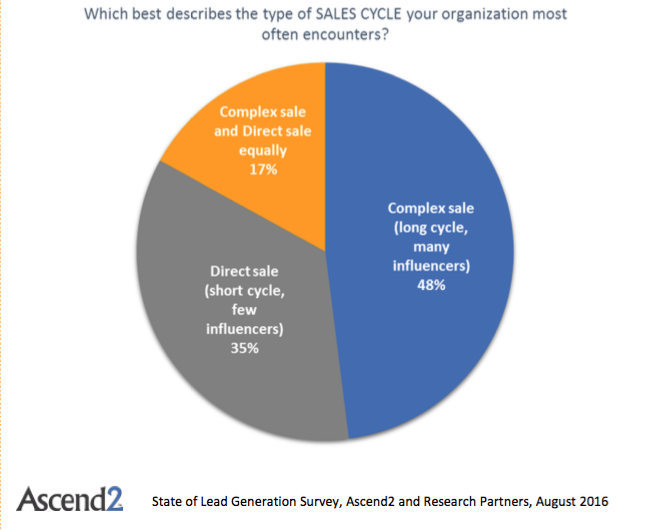
Source: Ventureharbour.com
Businesses that best employ lead nurturing observe a 50% increase in sales and a reduction of 33% in costs.
Based on these numbers, the conclusion is obvious: users will trust and buy from you, only after you prove you pay great attention to and anticipate their needs.
Content Marketing Funnel Explained: How to Build an Effective Content Funnel?
In order to simplify the process of creating your content marketing funnel you need to clearly establish some details like what you want to sell through the funnel. How do you want to sell the product? Where do you find the qualified traffic?
What product will your funnel sell?
If you have just one product/service, the answer is obvious.
If you have more, you should make a decision. Aim to build a funnel for a specific service/product, not a general one. For instance, a writer should not consider building a funnel for “writing services”, but for “content marketing writing services for the real estate industry”.
Being specific will facilitate your efforts in defining the stages of the funnel.
Take into consideration several criteria:
· Popularity of a product/service
· Potential of that product/service to drive sales (a product that can lead to selling other products, or services that involve more work)
· Ease to sell
As a general rule, a sales funnel should sell one product/service.
How do you sell the product/service? From where?
Depending on the specificity of your business the place where you place your pitch is different:
· Long-form sales pages – for courses, conferences
· Pricing pages – for books, software applications, consulting services
· Product pages – for online stores
Where do you find the qualified traffic?
Firstly, you can count on the traffic you have on your site or your email list (if you have one). Your existing visitors already know about you and are already positioned somewhere inside the stages of the funnel.
Sources of qualified traffic are:
· Existent traffic
· Subscribers list
· Organic traffic generated with SEO, social media
· Paid traffic through ads
· Partnerships with influencers and other specialists in your industry
Now that you have clarified the funnel basics, start with defining the content marketing stages:
The genuine art of converting means a flow and a funnel that doesn’t simply end with a sale. It’s a perpetual mission of reaching, keeping, and increasing your buyer persona base, using technology, content marketing, social media, email automation, etc. to satisfy better their needs.
It’s part of a broader marketing strategy that mixes lead nurturing, targets behavior uses retention tactics, and in the end, obtains referrals.
The Content Marketing Funnel Stages Are:
Top of the Funnel or TOFU (Awareness)
Middle of the Funnel or MOFU (Interest)
Bottom of the Funnel or BOFU (Decision + Action)
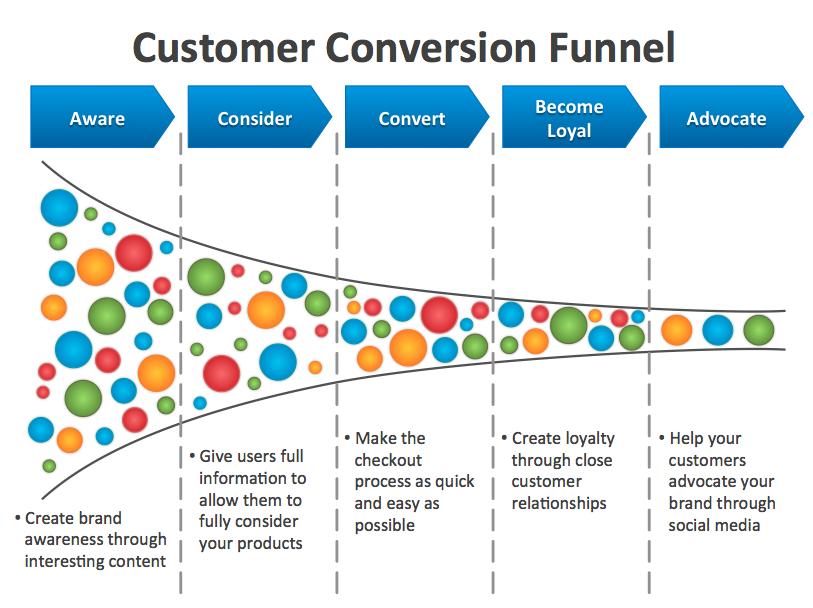
Source: Stefen Jeffes
If you do research, you will obtain various good-looking versions like these:
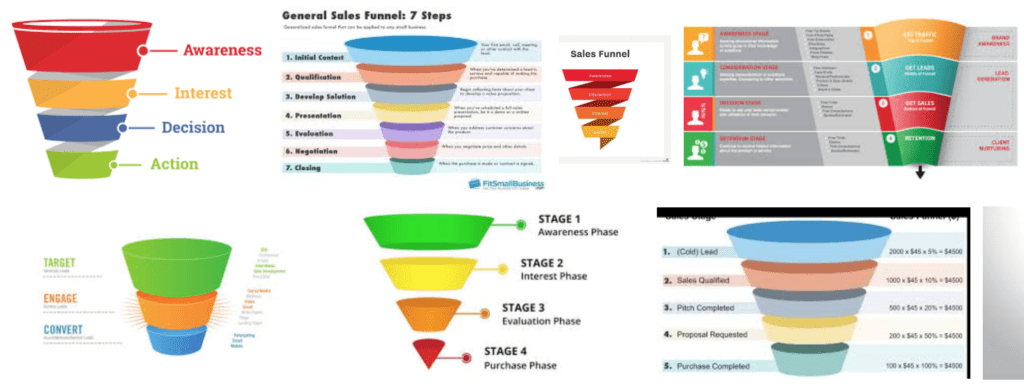
Source: Google
The content marketing funnel has a logical flow — it starts with generating awareness for your brand and problems it solves. Then Captures the interest of those users searching for a solution to such a problem. Attentively guides the flow to a purchasing decision. And arrives in the final stage of taking action and buying.
To each of these stages of the marketing funnel, you have to assign corresponding messages, that are buyer centric:
Content Marketing Funnel Stage 1: TOFU
The question is: which is the awareness level of my prospect?
This stage is the first contact point, you have to present your business, your mission, and your offer. You need to inform the users that you exist.
Most often this happens when:
* Traffic is redirected to your site from an advertising campaign
* Backlinks link to your site
* Your business is mentioned in a video, webinar, or podcast
* Word of mouth is spreading – happy clients make advocacy for your business
* Search engines pop your business within organic search
The essential is that awareness emerges when your activity appears in front of potential leads in places where they spend time.
On his side the customer may find himself in the so-called various stages of awareness, depending on the acknowledgment he has of his problem, existing solutions, and the role of your brand.
The famous copywriter Eugene Schwartz pinpointed several stages of awareness:
Not aware: the user doesn’t consider he has a problem, nor is looking for a solution, and knows nothing about your brand
Problem aware: the user suspects he has an issue, but no clue about a possible solution
Solution aware: the user knows his purpose but does not know your brand can be a solution.
Product aware: the user is familiar with your business and brand, and knows that you can offer a solution, but hasn’t decided that your product is his best option. The user is considering various options.
Most aware: the user had decided in favor of your product and just needs to take action and buy.
How long is the funnel and how much you have to work to convince the potential client, depends highly on which level of the above spectrum he is. This refers to individual parts of the buyers’ journey and also to the whole funnel.
If the client is in the “totally unaware” position of course the funnel will be longer and more convincing elements will be needed. The best case, from the sales point of view, is the most aware position when the prospect is prepared to become paying client.
Depicting where the potential client is on his journey, will help you identify elements that the client responds favorably to and moves him a step further in the funnel.
From the very beginning is vital to know exactly (research is important) which are the pain points and desires of your audience.
At this point, you have to indicate how your solution is a benefit for clients from various perspectives. Potential customers are in different stages of the content marketing funnel and a multi-direction approach can help generate more qualified leads.
Here is a funnel content marketing TOFU example from Self Publishing School:
Top of the funnel content: – land on the funnel from a Facebook ad:
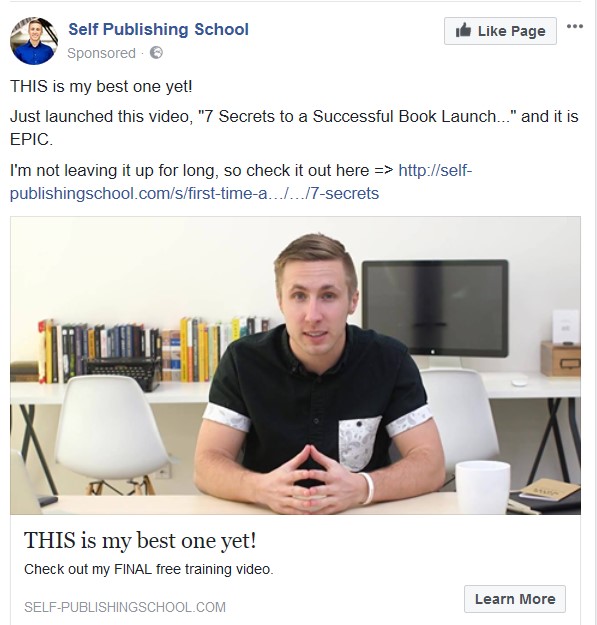
Source: Facebook
Or from an affiliate email:
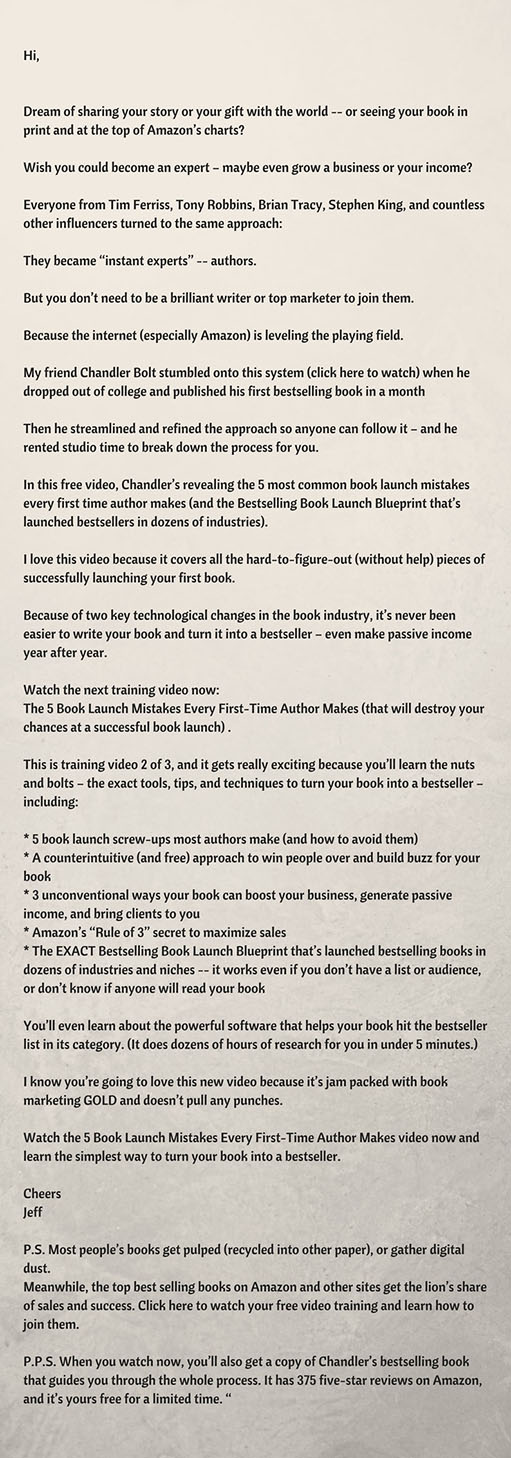
You have to show a potential client which is the value you deliver and how are you going to do it. You need to put in front something that clients value, not what you consider they judge as valuable.
Content Marketing Funnel Stage 2: MOFU
The question is: which problem fixes my product?
As a general idea, what you sell is not the product/service itself, but its benefits, and the improvements that it can bring into your client’s life.
Thus, it is compulsory to clearly depict the problems and issues that your product solves for your client and how it will impact his life after such problems are eliminated. And create the corresponding content to provide answers.
Consequently, you have to do your homework and search in detail which are the pain points, desires, and needs of your prospects, how they see your product, which issues appear while using it, which are their exact requirements, which are the messages that resonate better with your target audience.
Ask your clients, listen to them, and also check on forums or question-and-answer sites like Quora to get some answers. A keen understanding of your prospects’ needs and behavioral targeting will support you in your endeavors.
Remember: you encourage action to help your prospects solve their problems and in exchange, you endorse your brand awareness.
Using the exact words that clients use to describe their situation proved to be the most reliable option, as it helps improve conversions.
Speak to your audience in their language with their own words about your offer, why is it valuable, how is it different from your competition, and why is it a better alternative. Identify and answer all objections and fears your buyer persona might have even before their questions pop up.
To generate a high-converting funnel, you need to educate your audience concerning the benefits of your offer.
Craft informative articles on your blog, and make video demonstrations, tutorials, or testimonials to emphasize the value you offer. Open up the conversation, show your potential clients you are always open to discussing and listening to their problems and that you are easy to reach, that you actually care. Ask for feedback. Gain their trust.
Most often a clear sign of interest is subscribing to your email list. If a visitor of your site gives you his email, in exchange for a freebie, for example, this is clear proof of interest.
Sparkling interest is crucial for migration to the next level of the conversion funnel.
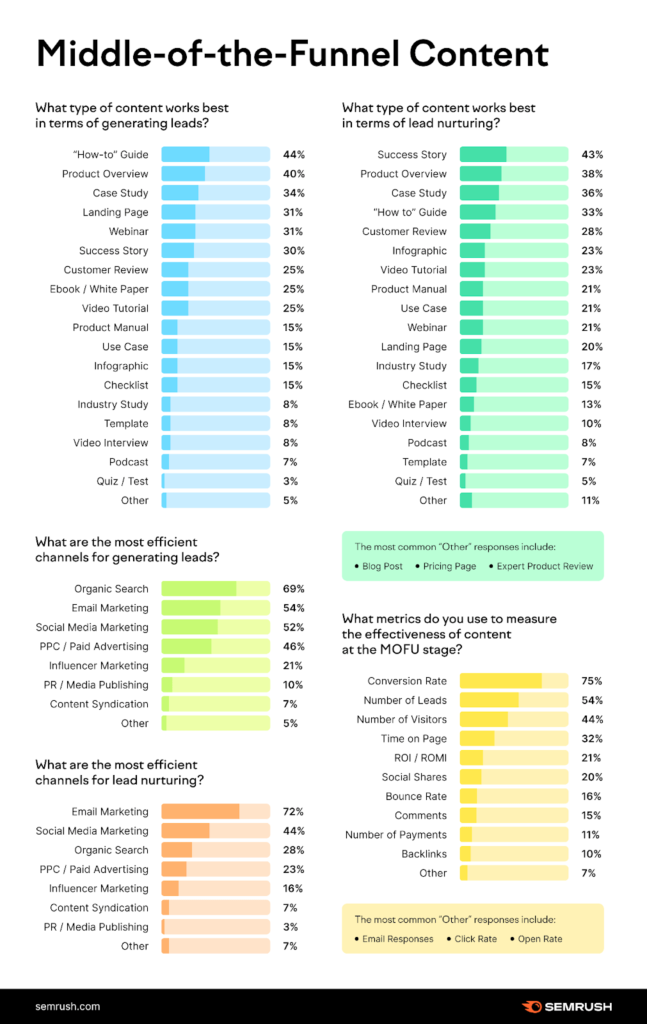
Source: Semrush
Content Marketing Funnel Stage 3: BOFU
The question is: What’s the leading need/desire that will make my prospect decide?
This stage relates to presenting prospects with your offer in a persuasive manner to make them decide if they buy or not.
The decision process is a function of your prospects’ purposes and desires. Even if their problems and struggles are the ones that are requiring a solution, their emotional needs are the real trigger of the decision.
Your message, to be effective should appeal to these deep emotional needs, the benefits of your offer should deliver at this level. Something like “we are the best in the world” or “we save you money” is not relevant enough.
You have to dig deeper to find meaningful answers. A way to discover this is to ask why until there are no questions left.
Practically this is a sales process. There are infinite options to arrive at this stage. Some ways are:
* Registering for a webinar
* A long-form sales page displaying the benefits of your offer, touching emotional needs, showing social trust, and testimonials
* Scheduling a free consultation where you speak about your offer
* An email series to warm the lead-up for the sale
Your Prospects Need to Take Action
Question is: why is my prospect still hesitating? Are there still unsolved concerns?
This is the purchasing stage. Prospects arriving at this stage will split into two categories:
· Those that are ready to buy, act and become customers
· Those that are not ready to buy, and you need to nurture them further
Not all prospects who arrived at this stage will buy, most of them will not, and that’s the reality. They will still have hesitations, for various reasons ranging from not trusting you to not being really convinced they need your product. Whether you like it or not, your visitors will have hesitations about buying from you.
It will be your task to minimize these hesitations by displaying the expected information in the right phase of the funnel. And how do you find that? What to say in which stage? Well, customer research is here to help you discover what to say, when, and also what makes your visitors stop and not act.
After passing through the above-mentioned sales funnel stages, from informing clients about your business, to rising their interest to having them engage in some form with your brand, it’s the moment to ask for the sale.
Now, your prospects should be prepared to trust you and your business. Use powerful attention-grabbing calls to action in emails, ads, and sales pages. Offer incentives to urge the need of buying, like limited discounts (20% discount if your buy in the next 15 minutes) or free bonuses.
The client bought it, end of story! Right?!
Wrong!! You should continue to engage your clients and transform them into evangelists of your offer.

Visuals are the first vector of sales.
Use Professional Styled Stock Photography to Promote Your Business.
And for those that finally didn’t buy, you have to continue your efforts by putting in place a marketing sequence. Send them a series of emails offering valuable information and propose another item from your sales funnels. Don’t waste such an opportunity!
The sales conversion funnels are in a continuous modifying cycle as clients modify their expectations and you should adapt your funnel to the new changing conditions. Improving user experience should be a top priority for you.
What will make your copy more compelling?
· Avoid ambiguity be clear and concise, people react better when they face known and calculated risks.
· Clear and common language is better than complex, people trust what they can understand quickly.
· Short and sweet, stay focused on the object.
Further Explanation for Your Content Marketing Funnel: Test It
After putting in place a coherent content funnel strategy, creating and settling in your funnel, you should always be looking for ways to improve it. And testing is the best method to do that. Be aware that you should focus on each stage of the sales funnel, not just on the awareness one. The final buying stage is more than important also.
Since you may have multiple pages that need testing, you need to filter and prioritize them. Start with the best performing and improve them if possible. Take a look at the implementation necessities: Are they easy to do or challenging from a technical point of view and require lots of time? Which is the conversion value brought by these modifications? How likely is it to have more prospects that convert?
Provided that you choose which pages are to be tested, they should go live and the results to be tracked.
Firstly, you have to set some realistic conversion goals and pick a tracking system, like Google Analytics. Analytics tracks the users on your site and provides a series of information like sources of visitors, how long they spend on your site, which country are they from, and which device and browser they use to connect.
Tools like Google Analytics support you in testing, refining, and optimizing your funnel.
Here you have it – a detailed content marketing funnel explanation and a game plan to convert your next funnel into a journey that inspires your customers and multiplies your sales.
Frequent Asked Questions
A full-funnel content strategy is a strategy that takes into consideration also the stages of the buyer journey and plans adequate content for each step of the content funnel (top of the funnel, middle of the funnel, bottom of the funnel).
The four stages of the marketing funnel are awareness, interest, decision, and action.
An example of a marketing funnel could be the series of steps that a potential client takes when he finds out about a brand via organic search, goes to the brand’s website, reads some articles and case studies, subscribes to the newsletter, and after a while buys the products/services that the brand provides.
